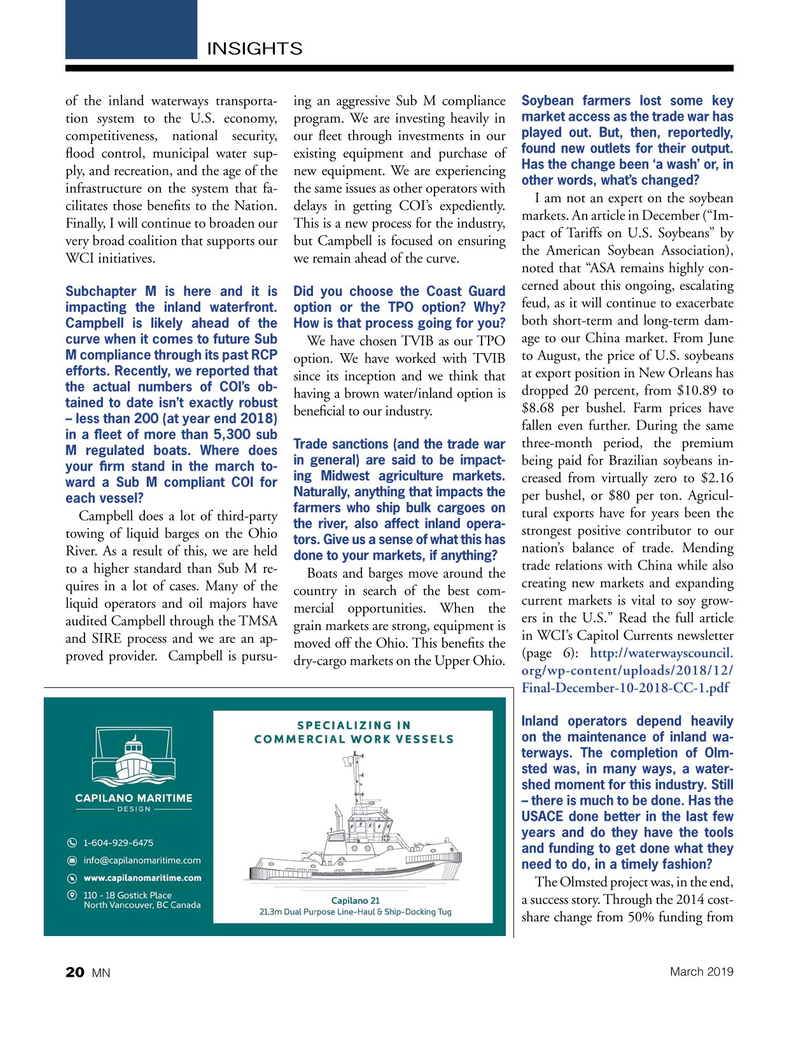
Page 20: of Marine News Magazine (March 2019)
Pushboats, Tugs & Assist Vessels
Read this page in Pdf, Flash or Html5 edition of March 2019 Marine News Magazine
INSIGHTS of the inland waterways transporta- ing an aggressive Sub M compliance
Soybean farmers lost some key market access as the trade war has tion system to the U.S. economy, program. We are investing heavily in played out. But, then, reportedly, competitiveness, national security, our feet through investments in our found new outlets for their output. food control, municipal water sup- existing equipment and purchase of
Has the change been ‘a wash’ or, in ply, and recreation, and the age of the new equipment. We are experiencing other words, what’s changed?
infrastructure on the system that fa- the same issues as other operators with
I am not an expert on the soybean cilitates those benefts to the Nation. delays in getting COI’s expediently. markets. An article in December (“Im-
Finally, I will continue to broaden our This is a new process for the industry, very broad coalition that supports our but Campbell is focused on ensuring pact of Tariffs on U.S. Soybeans” by the American Soybean Association),
WCI initiatives. we remain ahead of the curve.
noted that “ASA remains highly con- cerned about this ongoing, escalating
Subchapter M is here and it is Did you choose the Coast Guard feud, as it will continue to exacerbate impacting the inland waterfront. option or the TPO option? Why? both short-term and long-term dam-
Campbell is likely ahead of the How is that process going for you?
curve when it comes to future Sub
We have chosen TVIB as our TPO age to our China market. From June
M compliance through its past RCP option. We have worked with TVIB to August, the price of U.S. soybeans efforts. Recently, we reported that since its inception and we think that at export position in New Orleans has the actual numbers of COI’s ob- having a brown water/inland option is dropped 20 percent, from $10.89 to tained to date isn’t exactly robust $8.68 per bushel. Farm prices have benefcial to our industry.
– less than 200 (at year end 2018) fallen even further. During the same in a feet of more than 5,300 sub three-month period, the premium
M regulated boats. Where does Trade sanctions (and the trade war in general) are said to be impact- being paid for Brazilian soybeans in- your frm stand in the march to- creased from virtually zero to $2.16 ward a Sub M compliant COI for ing Midwest agriculture markets.
Naturally, anything that impacts the per bushel, or $80 per ton. Agricul- each vessel?
farmers who ship bulk cargoes on tural exports have for years been the
Campbell does a lot of third-party the river, also affect inland opera- strongest positive contributor to our towing of liquid barges on the Ohio tors. Give us a sense of what this has nation’s balance of trade. Mending
River. As a result of this, we are held done to your markets, if anything?
to a higher standard than Sub M re-
Boats and barges move around the trade relations with China while also creating new markets and expanding quires in a lot of cases. Many of the country in search of the best com- liquid operators and oil majors have mercial opportunities. When the current markets is vital to soy grow- ers in the U.S.” Read the full article audited Campbell through the TMSA grain markets are strong, equipment is and SIRE process and we are an ap- moved off the Ohio. This benefts the in WCI’s Capitol Currents newsletter (page 6): http://waterwayscouncil.
proved provider. Campbell is pursu- dry-cargo markets on the Upper Ohio.
org/wp-content/uploads/2018/12/
Final-December-10-2018-CC-1.pdf
Inland operators depend heavily on the maintenance of inland wa- terways. The completion of Olm- sted was, in many ways, a water- shed moment for this industry. Still – there is much to be done. Has the
USACE done better in the last few years and do they have the tools and funding to get done what they need to do, in a timely fashion?
The Olmsted project was, in the end, a success story. Through the 2014 cost- share change from 50% funding from
March 2019 20 MN

 19
19

 21
21
